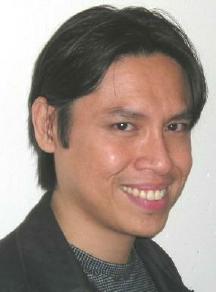
|
|
 |
| Global Perspective |
| May 24, 2005 | Vol. 3, No. 4 |

Antonio David Sison is a Filipino theologian, screenwriter and independent filmmaker. For his doctorate, he researched the confluence of Edward Schillebeeckx's eschatology and Third Cinema. He is currently in the Special Formation Program of the Missionaries of the Precious Blood in Dayton, Ohio. His e-mail is ton_sison@yahoo.com. |
Eyes Wide Open: Filming faith in secular Dutch cultureBy Antonio D. Sison
-- Voice-over from the opening of "Mariken's Divine Stampot"
For those who know me, the opening narration of "Mariken's Divine Stampot", my 36-minute art film, sounds autobiographical. After all, I was on a doctoral grant to do research on the confluence of Theology and Cinema at the Catholic University of Nijmegen (now Radboud University) in the Netherlands. But this film project was a departure from academic work: a much needed right-brain excursion. I had written screenplays before, but I was thrilled at the prospect of actually shooting my first digital film. I was doubly excited because I had ample room for creative expression, having decided to do a "mockumentary," my spin on reality, rather than a straightforward documentary.
I began my search by casting a keen eye on the colorful people I had come to know and be friends with. Astute, frank to a fault, and as quirky as the weather to which they are so accustomed, the Dutch fondly refer to themselves as "undutchables." I pared down my main characters to three: a young video store employee who, as a self-confessed atheist, experiences the mystical in the movies he loves to watch; a self-styled guru of Hinduism and Buddhism who is committed to neither of the eastern religions; and a young gothic lady who struggles with questions of mortality but chooses life in the end. As my concept bloomed into a shooting script, these characters took on lives of their own, so close to their real referents, but morphed into cinematic visual symbols. I found it fitting to use satire and irony as a modest tribute to my film subjects.
I had five days to shoot all the footage I needed, breakneck-speed filming by any standard. Working around the schedules of my unpaid volunteer actors, I found myself sapped of strength at the end of each day. But that's half the story. Each shooting day, I had to "log" my shots, that is, mark each and every one of them on paper for easy editing later on. As shooting days stretched long and sleeping hours rudely shortened, things shaped up surprisingly well. My Dutch actors were naturals, very much at home with the camera. I was very happy to have had a good deal of "one-take wonders." Nature also proved to be a great assistant director. It was the last day of the annual carnival and I was waiting for workers to pack-up the tarpaulin tents that blocked the view of my subject for the day -- the statue of Mariken van Nijmegen, mythological symbol of the city. I was worried sick that I would not be able to complete shooting at all. The videocam was due to be returned that afternoon and I had already wasted some six agonizing hours just waiting. When the last of the tents were taken down, I rushed toward the statue to finally shoot. Then it started to snow. And even as I delighted in the visual poetry unfolding in my videocam monitor, a bird flew gracefully across the screen. I had the perfect closing shot!
The late Dutch Emeritus Professor Theo Beemer, who provided housing for me for a couple of years, once remarked that no matter how secular Dutch culture appears to be, he refuses to believe that faith is dead. After my film experience, I have come to understand and share that hope. "Faith" still exists in secular Dutch culture. If you keep your eyes wide open… or perhaps, wide shut. Editor's Note:The short art film "Mariken's Divine Stampot" was privately screened by a select audience in Manila, the Philippines, and Nijmegen, The Netherlands in early 2004.Total budget for the film was 400 euros or about US$500. |
| Copyright
© 2004 The National Catholic Reporter Publishing Company, 115
E. Armour Blvd., Kansas City, MO 64111
TEL: 1-816-531-0538 FAX: 1-816-968-2280 |